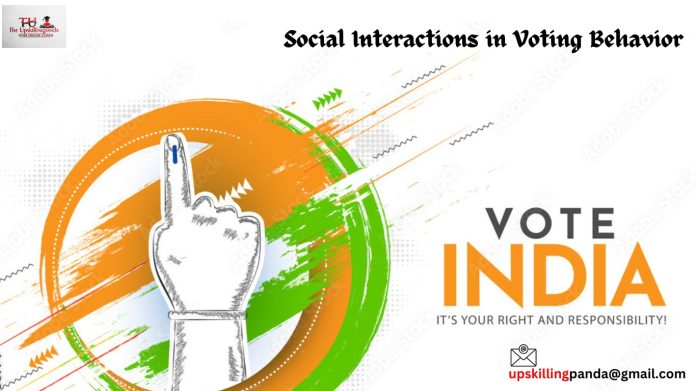Indian electoral behavior is a complex and multifaceted phenomenon shaped by various social, economic, cultural, and political factors. Here are some key aspects that influence Indian electoral behavior:
Caste-Based Voting: Determined by caste affiliations and perceptions of parties’ representation of certain castes.
Religion-Based Voting: Influenced by religious identity and parties’ alignment with religious interests.
Regional Voting Patterns: Driven by regional issues, language preferences, and historical grievances.
Youth Voting: Determined by youth-centric policies, social media influence, and aspirations for change.
Urban-Rural Divide: Shaped by differences in developmental priorities, access to resources, and lifestyle preferences.
Gender Voting: Influenced by gender-specific policies, women’s empowerment initiatives, and societal norms.
Educational Background: Higher education correlates with awareness of political issues, critical thinking, and policy-based voting.
Occupational Affiliation: Influenced by the impact of government policies on specific industries or occupations.
Income Levels: Higher income correlates with concerns for economic growth, taxation policies, and welfare schemes.
Accessibility to Basic Services: Voting choices are influenced by access to healthcare, education, water, and sanitation facilities.
Media Exposure: Determined by the influence of mass media, social media, and political advertising on voter perceptions.
Incumbency Factor: Influenced by the performance of the ruling government, delivery of promises, and anti-incumbency sentiment.
Leadership Perception: Shaped by perceptions of political leaders’ leadership qualities, charisma, and communication skills.
Party Ideology: Determined by alignment with voters’ ideological preferences, such as liberalism, conservatism, or socialism.
Welfare Schemes: Voting is influenced by the effectiveness and coverage of government welfare programs and subsidies.
Law and Order Situation: Influenced by perceptions of safety, crime rates, and government’s ability to maintain law and order.
Historical Voting Patterns: Continuity in voting behavior influenced by historical party affiliations and family traditions.
Social Movements: Influence of social movements, activism, and civil society organizations on voter consciousness and mobilization.
Economic Development: Voting patterns are shaped by perceptions of economic progress, job creation, and infrastructure development.
Coalition Dynamics: Determined by pre-poll and post-poll alliances between political parties, influencing voter calculations and strategic voting.
Here are some key factors that can influence youth voting behavior in India:
Socio-economic background: Economic status, education level, and social background play a significant role. Youth from more affluent backgrounds or with higher levels of education may be more politically aware and active compared to those from marginalized communities.
Political Awareness and Education: Understanding of political issues, government structures, and the importance of voting can influence youth participation. Education programs, civic education in schools, and political discussions within families and communities can impact this awareness.
Political Parties and Leaders: The appeal of political parties and their leaders can sway youth voting behavior. Parties that effectively communicate with youth, address their concerns, and offer appealing policies may attract more youth voters.
Social Media and Technology: The rise of social media has transformed political engagement among youth. Platforms like Facebook, Twitter, and Instagram are used by political parties for outreach, and they can influence youth opinions and mobilization efforts.
Identity and Ideology: Factors like religion, caste, ethnicity, and regional identity can influence voting behavior, especially in India with its diverse population. Youth may align themselves with parties or candidates that they perceive as representing their identity or ideology.
Issues and Policies: Youth may vote based on specific issues that affect them, such as unemployment, education, environment, or social justice. Parties that address these issues effectively may gain support from youth voters.
Peer Influence and Social Networks: Peer pressure and social networks can play a significant role in shaping youth voting behavior. Youth may be influenced by their friends, family members, or influential figures within their communities.
Trust in Political Institutions: Perceptions of political institutions, including government, parliament, and electoral processes, can influence youth participation. Lack of trust or disillusionment with these institutions may deter youth from voting.
Accessibility and Convenience: Practical factors like voter registration processes, polling station locations, and ease of voting can affect youth turnout. Efforts to improve accessibility and convenience, such as online voter registration or mobile voting options, may increase youth participation.
Campaigning and Mobilization Strategies: Political parties often deploy targeted campaigns and mobilization strategies to engage youth voters, such as rallies, youth forums, concerts, and celebrity endorsements. Effective outreach efforts can motivate youth to participate in the electoral process.
Understanding these factors is crucial for policymakers, political parties, and civil society organizations seeking to encourage youth participation in the democratic process in India.These determinants interact in complex ways to shape voting behavior in India, reflecting the country’s diverse social, economic, and political landscape. Understanding these factors is crucial for political parties, policymakers, and analysts to anticipate voter preferences and formulate effective electoral strategies.

Prof. Satya Sidhartha Panda
Founder
The Upskillingpanda
Skill Enabler | Career Catalyst I Human Architect I Author
Bengaluru, India

